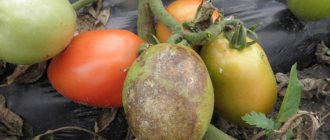Why tie up tomatoes?
Three main reasons:
- To save the plant. Without a garter it is quite difficult to maintain the integrity of the bush. Some varieties reach a height of more than 2 meters. As a result, they fall and break under their own weight. Low-growing bushes have a lower risk of fracture, but when not tied up, they drop their fruits to the ground. On the ground, tomatoes receive less light and air, and are often attacked by insect pests and rot.
- To improve the quality of the harvest. Gartering tomatoes allows you to get a better harvest. Straight, straightened, vertically positioned bushes literally bathe in sunlight and are well ventilated. They grow better, and the fruits are larger in size, bright in color and have excellent taste.
- To make caring for the plant easier. Bushes tied to a support are more convenient for watering, hilling, weeding, spraying, and pinching. In addition, the effectiveness of the procedures in this case will be significantly higher.
The result is healthy plants and a rich, high-quality harvest.
Who first came up with the idea of tying the bushes to a support - history is silent.
Probably, our ancestors, when they began to massively grow the strange berry imported from Peru, noticed that the capricious crop tied to pegs gives an excellent harvest and does not rot on the vine.
In the most productive years for tomatoes, when the bushes break under the weight of ripe fruits, there is nothing left to do but tie the stems, fixing the heavy side shoots.
Of course, there are gardeners for whom this is extra labor and they even manage to get good results. They are either lucky, or they water the seedlings against diseases with chemicals.
The goal of a real gardener is to grow a natural product that cannot be bought on the market. Its own, environmentally friendly.
So, gartering tomatoes is recommended to:
- relieve branches and stems from the weight of fruits and prevent branches from breaking off;
- protect plants from late blight by ensuring good ventilation between the bushes and preventing the lower leaves from rotting;
- let the sun shine evenly on the entire bush so that the tomatoes ripen quickly and amicably;
- provide convenient access to each bush for treating it from pests and harvesting;
- properly water the bushes at the roots and hill up the beds;
- simplify care - pinching, breaking off lower leaves, loosening the soil at the root.
So it’s worth devoting a few hours of country life to tying up the bushes in the tomato beds.
Gardener mistakes
A common mistake gardeners make is using unprocessed materials. Only those devices that have been treated with disinfectants are suitable for use. If this is not done, you will introduce infections and fungal spores to new plantings, destroying most of the crop.
There are other errors:
- high installation speed. If you want to quickly tie up your tomatoes, be prepared for possible damage to the bushes. When carrying out this procedure, do not rush, because... damage to the shoots will reduce the number of formed fruits;
- hilling. If the crop needs hilling, you should not dig out supports to facilitate the process. Try to do this work carefully so as not to disturb the settings;
- use of low-quality materials. Tying tomatoes is a costly process. By saving on the purchase of equipment, you risk losing most of the future harvest;
- tight tying will lead to deterioration of the bush’s vegetation;
- installation of lightweight structures that break under the weight of the fruit;
- fastening side shoots with a stapler or tapener. This disrupts the structure of the plant.
Rules for gartering tomatoes
How to properly tie tomatoes? This process should be approached responsibly. The recommendations have been developed through years of experience as amateur gardeners and scientific works of vegetable growers. You shouldn’t ignore the advice, and there’s no need to reinvent the wheel when everything is clearly and clearly formulated - how to tie up tomatoes correctly and in a timely manner.
If you take a closer look at the experience of large agricultural enterprises that are engaged in greenhouse cultivation of tomatoes. They have each plant tied to a trellis. Workers make sure that not a single branch breaks. The harvest and, of course, income depend on this.
For an ordinary summer resident, the main thing is not money - but the value of his work and a good harvest of delicious tomatoes for his beloved family.
The rules for gartering are not that complicated, it’s worth remembering them:
- The key to getting a good result will be timely tying up the bushes. In greenhouses, seedlings are tied to a support a week after planting. As it grows, the stem is wrapped around a cord.
- Before gartering, the first pinching of bushes is carried out.
- Ground tomatoes begin to be tied up when the bushes grow so large that an ovary forms on them and they can break from gusts of wind.
- Before installing the supports, the soil needs to be watered. Wet soil will seal the holes and will not crack after drying. If this rule cannot be neglected, dry soil will damage the roots.
- The central stem of the tomato is tied first, and after the fruits have formed, the branches are fixed, which may break off under the weight of the fruit.
- The stem must not be pinched. The garter is done freely.
- To prevent next year's crop from transmitting diseases, old garter material is removed from the area and disposed of.
- Tall bushes are first attached under the lower brush, then higher.
- It is enough to secure low-growing tomatoes in the middle of the main stem.
- Between the bush and the support, free space is left for the plant to grow.
There are only 10 rules that cannot be ignored. With this method of growing, plants get sick less and the yield is higher.
Deadlines
The main task of tying up tomatoes is to ensure normal air circulation in the garden bed, access to each bush, and so that the branches do not break. The bush cannot be allowed to overgrow in order to form an even main stem in time.
The bushes are tied to a support when they begin to bend. At this time, the stem reaches the desired thickness and height. The bush has already formed up to 10 true leaves. A strong bush is no longer a tender seedling that can be easily damaged when staking.
Tomatoes can be divided into three varietal groups - early-ripening, mid-ripening and late-ripening tomatoes. The tying time for each variety after planting seedlings in the ground or under film is as follows:
- early varieties - from 35 to 40 days;
- mid-ripening varieties - at 50-60 days;
- late varieties - at 70-80 days.
The garter period depends on the growing region, soil quality, fertilizing and other factors affecting plant growth. Over time, experience is gained and the gardener himself is able to determine a convenient time.
Unusual ways to support tomatoes
Non-standard methods are associated in the configuration of structures of unusual supports. I suggest you get to know them in a little more detail.
Well suited for these purposes:
- thorny blackberry branches;
- hazel;
- willow twigs;
- trimmed branches from seedlings;
- various vines, vines or regular twine.
Garter material
The choice of material for a garter must be approached with all responsibility. It is important to know what and how to tie tomatoes. The garter should not cut the delicate surface of the stem and branches, accumulate moisture and rot. It should be convenient to make knots without fear that the twine or strip of fabric will tear. The garter material is prepared for one season, and after harvesting it is destroyed to exclude the possibility of transferring the infection to the next year.
It is prohibited to tie up tomato bushes:
- wire;
- thin twine;
- fishing line.
It is better to prepare strips of synthetic fabric up to 5 cm wide and quite long. This can be a nylon utility cord, ordinary twine, or nylon stockings cut into strips.
Tomato garter clips make the job much easier. They come in wood or plastic, are very inexpensive, and are sold individually and in sets. The clip wraps around the stem and snaps into place without pinching it.
When tying with improvised material - strips of fabric or soft ties, you only need ordinary scissors.
And if you have garden tapeners, there is no need for either scissors or material for gartering.
A tapener is a simple device into which adhesive tape is inserted, capturing the stem of the plant along with a peg, mesh cell, and wire. Designed to simplify and speed up gartering. It works on the principle of a stapler, but looks like a garden pruner. A soft ribbon is tucked into the device and carefully bends around the stem. It is very convenient to use, and with a trellis-type garter, when the tomatoes are tall, this is an indispensable tool.
The handles are comfortable, the hand does not get tired. In any online gardening store you can buy a tapener with a set of tapes, staples, a spare knife and a replacement screw. This tool is also useful for tying grapes, cucumbers, and other tall crops.
Tips and tricks
Tying up bushes is accessible even to inexperienced gardeners, since this procedure does not require any skills:
- Experienced gardeners advise using new materials every year to attach stems to supports, since flaps of fabric can become infected;
- It is important to disinfect the equipment that will be used before the procedure. The easiest way is to boil the material;
- All actions must be carried out consistently, without haste. Care should also be taken to avoid damaging the plants.
Garter of tomatoes in a greenhouse
When tomato seedlings are grown in a greenhouse in a limited area, special attention is paid to the garter, because greenhouse varieties are usually tall. For example, a specially bred variety for growing in a greenhouse is “Eagle Heart”. The weight of one tomato reaches 800-900 g, and the height of the stem is 170 cm. How can such a giant be left without a garter?
And even the shortest greenhouse cherry tomatoes grow up to 90 cm. If you don’t know when and how to tie up tomatoes, branches with numerous fruits can break off.
Tomatoes in greenhouses are tied up for:
- harvest preservation;
- friendly maturation;
- ensuring watering strictly to the root;
- ventilation of beds;
- convenience of courtship;
- protection from diseases and pests.
How to tie tall tomatoes
Tall varieties are not intended for regular cultivation. Only on supports. The peculiarity of the garter is the reliable fixation of the stem and side branches. Moreover, the operation should be done so as not to pinch the fragile stems, otherwise the plant will die, and the tomato trusses will remain green.
To understand how important it is to properly tie up tomatoes, it is worth remembering: that thanks to this technique, caring for the crop is much more convenient, and harvesting is much faster.
Rays of light penetrating through polycarbonate or glass are not lost in the thickets of plants, but evenly illuminate each bush, and this contributes to the smooth ripening of fruits.
All the fruits are visible; it is much more difficult to miss already ripe fruits.
Purpose and necessity of the design
A practical and stable support for tomatoes helps to simplify the procedures for caring for tomato bushes; tied bushes are easy to weed and remove weeds, water and feed in a timely manner.
Reliable structures are stationary and portable, so they can be constantly used in farming to effectively increase the yield of various and popular garden crops.
Tying options
To secure tomato stems over the beds, several methods of tying tall tomatoes are used:
- Pegs - a high rail is driven in at a distance of at least 10 cm from the bush, a rope or strip of fabric is tied with a loose knot to the peg, wrapping around the stem. As it grows, it makes a few more bindings.
- A simple design for greenhouses consists of supports on which a block is attached. Instead of a block, you can stretch a wire with a cross-section of 3-4 mm so that there is no sagging. A long string is tied to the top bar or wire and goes down to the bush. It is secured with a loop at the base of the stem. As the bush grows, it wraps itself around the twine.
- Wire hooks - synthetic twine is tied onto a cable stretched along the bed. Loops are made on the twine along its length at a distance of 25 cm, wire hooks are threaded through them and the twine is tied to the lower cable. Rubber loops are used for garters. They are wrapped around the stem and the two ends of the elastic are put on a hook.
Tying to a separate support or to stakes
In small country greenhouses it is not possible to build a bulky structure in order to tie up a couple of dozen tomato bushes. For such conditions, the method of tying tomato bushes to a separate support is used. In other words - a regular garter to pegs.
This method is suitable for compact tall and medium-growing varieties. Metal or plastic pipes, tall wooden stakes, and rods are used as support. They should be a couple of tens of centimeters higher than the bush, but in such a way as not to damage the roof of the mini greenhouse. The stems are tied using strips of synthetic fabric or a special tying machine.
One of the easiest ways to tie a garter is with stakes. All that is required are pegs for tying tomato bushes and twine. This method is suitable for medium-sized and short varieties of tomatoes. One peg is used per bush. The stem is grabbed in the middle and a couple more times as it grows. Compact bushes do not branch much and the side branches do not require separate support.
The height of the peg is calculated in this way - 20-25 cm will be used for digging into the ground, 25-30 cm for the height above the bushes. That is, when sawing the material, you need to know what the expected height of the tomatoes is.
A tall bush is rarely tied to stakes; after all, the 2-2.5 m height and plus the load of the bush with fruits makes such a structure too unreliable. For these types of tomatoes there are other methods of gartering.
In addition to wood, metal rods and plastic are used for pegs. Craftsmen prepare stakes themselves from scrap materials, but you can save time and buy ready-made products in the store.
The pegs are installed when the seedlings have grown and the bush is ready to bend. The support is stuck into the ground 10-15 cm before the stem and tied loosely.
After harvesting, the material is pulled out of the ground, thoroughly cleared of soil and stored in a place so that pathogens freeze out in winter.
What to make pegs for gartering tomatoes from
Pegs for gartering tomatoes
Usually stakes for low-grade tomatoes are made from sawn wooden blocks. The thickness can be any, but take into account that the support must hold the plant in an upright position in any weather.
Material suitable for pegs:
- Tree. Smooth tree branches are cut out and the bark is removed from them. The branches are sawn into stakes of the required length. Cheap and accessible.
- Wooden slats, old picket fence. If you plan to use such pegs for several years, it is recommended to burn the bottom edge at a fire to protect the wood from rotting.
- Metal – fittings, pipes, metal profiles, corners. Since metal is expensive and rusts, there is no point in buying fittings. It’s another matter if it remains after construction work.
- Fiberglass is an alloy of metal and plastic. The material looks aesthetically pleasing, does not rot, does not rust, and has sufficient strength. The diameter of fiberglass pegs is recommended to be at least 8-10 mm. For stakes, a fiberglass rod with a diameter of 8-9 mm, reminiscent of metal reinforcement, twisted into a coil is also used.
- As an option: ready-made plastic stakes are sold in construction and gardening stores. A metal rod is inserted inside such a peg for strength. The stakes do not rot and do not corrode.
On a wire frame
An interesting method of gartering, cost-effective only for small plantings of tomatoes. To implement this method, you need to buy a roll of coarse mesh and cut it into pieces in order to make frames.
A wide pipe is installed above a grown bush. As they grow, the stems and branches with tomatoes are attached to the mesh cells. This method has a clear disadvantage - high cost and inconvenience during harvesting.
Dome
If there are only a few tall tomato bushes growing on the site, you can make a so-called dome to tie them up. This is the fastest way to install a support. Around the growing bush, three supports are buried in the ground. They are connected at the top. This results in a stable structure. The tripod is braided from top to bottom with rope or wire.
Such devices are installed with the planting of seedlings. Two or three bushes are planted around the domes at once. You need to make sure that the branches do not grow inside the stakes, since the tomatoes will be inconvenient to tie up.
It is easier to use stakes as supports. They are lightweight and easy to work with. For the dome, you can buy plastic or metal stakes. Ready-made prefabricated domes are ordered in gardening stores and online.
Vertical trellis
Gartering a tomato using a trellis is a simple method. In the garden bed where it is planned to grow tomatoes, a stationary structure is installed:
- supports are driven in along the bed on both sides;
- the ropes are stretched and secured at the same distance from each other;
- seedlings are tied to ropes.
A stationary trellis for open ground is made from pipes or bars dug into the ground. The distance between the posts should be no more than 2 m, and the digging depth depends on the soil. For example, on clay soils the supports go 60 cm into the ground, and in sandy soils 1 m or deeper. Together with a stretched mesh or cord, the structure must support the weight of the crop.
Linear mount
This is an economical and easy to implement option:
- in the greenhouse, loops are attached to the ceiling or a cable is pulled;
- a long twine or rope is attached to the cable;
- the rope is fixed near the bush into the ground;
- the stem grows and wraps around a rope, which acts as a kind of rod, holding the trunk. For reliability, the stem is additionally secured with clips or garters.
Mesh mount
A method that gardeners love. Has a clear advantage over others. The garter system is made like this - a large-mesh dense plastic mesh or aluminum chain-link mesh is fixed between the supports, which are dug in along the bed. Seedlings are planted along it. As the bush grows, all that remains is to tie up the central trunk and side shoots.
The support made of plastic mesh stretched between the posts looks neat. Stems and branches can be tied directly to the cells.
There is also a combined option that combines trellis fastening and fixation with mesh. A metal or plastic mesh is stretched between the supports, which allows you to place powerful and compact tomatoes, so gartering on a mesh is suitable for all types of tomatoes.
Trellis for closed ground
In greenhouses and greenhouses, it is recommended to use low, but most reliable supports to preserve plants and crops, which is facilitated by the mandatory staking of plants; such a structure can be built independently.
Metal-plastic pipes are used as supports, inserted vertically into the soil and filled with sand for stability; using special fasteners, horizontal guides made of elastic and soft cord are fixed on them (at different heights) for tying up plants.
How to tie up tomatoes when growing in open ground
To ensure normal growth and fruiting for tomatoes, two conditions must be met - to prevent branches from breaking off and contact with the ground. We are talking about gartering tomatoes planted in open ground.
Methods for gartering tall tomatoes in open ground differ little from greenhouses. The most popular option is a trellis. There are some features of this operation for ground varieties - medium-growing and low-growing tomatoes.
Medium-sized varieties
To grow medium-sized tomatoes in the garden, make wide row spacing and always try to tie up the tomatoes in open ground. Still, bushes can grow up to a meter, and then the stem will not withstand the load and bend towards the ground. It is more likely that the tomatoes will begin to hurt, and snails and slugs will devour the fruits from below.
Beginning gardeners are wondering: how to properly tie up medium-sized tomatoes in open ground? There is nothing complicated. You can use any method - on pegs, dome, net. For garters, use synthetic material or cord that will not rot from moisture.
Low growing varieties
There is an opinion that it is not necessary to tie up low-growing varieties. Strong, stocky bushes do not need additional support. Yes, if the weather is perfect all summer, then let them grow. But, unfortunately, strong gusty winds, rain, and hail are not uncommon. Then tying up low tomatoes in open ground will save the harvest.
Ordinary wooden pegs or a metal rod are suitable for this purpose. If you want aesthetics, you can buy a set of ready-made plastic stakes and admire the neat rows of tied tomatoes.
Definition of trellis, what is it
Bushes fixed on special supports and carefully tied up in practice give a larger harvest; a trellis is a supporting structure that can withstand sufficient loads and is not difficult to make yourself.
The trellis is installed on vegetable beds and can be of different configurations; in addition to a stable frame, its design includes longitudinal and transverse guides necessary for tying up plants of different heights or for a certain period of growing season and development.
Common mistakes when gartering tomatoes
Gartering tomatoes is one of the methods for obtaining a bountiful harvest, but all the work will be in vain if you make mistakes. Here are the typical mistakes inexperienced gardeners make:
- use hard material, squeezing shoots and stems;
- they tie with last year’s garters, untreated from pathogenic microbes, and infect young plants;
- the twine is knitted lower than necessary, without providing stability to the bush;
- take pegs lower than an adult bush, such a garter of tomatoes does not make sense;
- For tying, electrical tape is used, which prevents the stems from growing in width.
Interesting ways to garter
Fans of experiments have come up with a non-standard approach to the question of how to tie tomatoes planted in open ground. A thrifty owner will never throw away a single piece of hardware or a single item and will come up with a use for it.
For example, an unnecessary television antenna turns into an excellent support for tall tomatoes. Cylindrical cages are made from steel wire and dug into the ground around the plant. Caps are made from improvised materials, around which seedlings are planted.
In principle, what difference does it make which method is used? The main thing is that the task of gartering the tomatoes is completed. The result is a good harvest on healthy bushes.
Types of tomato trellises
According to the generally accepted classification by design, supports are divided into trellises for open and closed ground. When choosing which type of supports is best to make, it is necessary to focus on a set of their operational characteristics.
It is important that the trellis ensures free movement between the beds, provides excellent ventilation of the tomato bushes and facilitates the harvesting procedure, without damaging the ripened fruits, which is important for their subsequent storage and processing.











